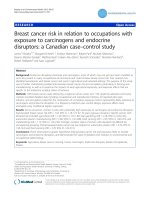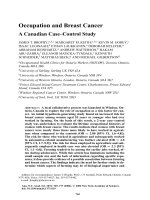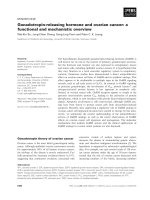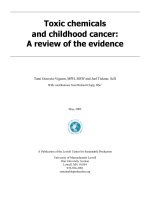Delayed presentation in breast cancer: a study in Iranian women docx
Bạn đang xem bản rút gọn của tài liệu. Xem và tải ngay bản đầy đủ của tài liệu tại đây (245.14 KB, 6 trang )
BioMed Central
Page 1 of 6
(page number not for citation purposes)
BMC Women's Health
Open Access
Research article
Delayed presentation in breast cancer: a study in Iranian women
Ali Montazeri*, Mandana Ebrahimi, Neda Mehrdad, Mariam Ansari and
Akram Sajadian
Address: Iranian Centre for Breast Cancer (ICBC), Tehran, Iran
Email: Ali Montazeri* - ; Mandana Ebrahimi - ; Neda Mehrdad - ;
Mariam Ansari - ; Akram Sajadian -
* Corresponding author
Abstract
Background: A cross sectional study was conducted in Tehran Iran to examine the extent of
patient delay and associated factors in the presentation of breast cancer.
Methods: A group of newly diagnosed breast cancer patients were interviewed and were asked
about the period from first onset of symptoms to first medical consultation to indicate patient
delay. This was studied in relation to patients' age, educational level, marital status, family history
of breast cancer, history of benign breast disease, number of children and the nature of the first
symptom seen.
Results: In all, 190 breast cancer patients were interviewed. Of these, 75% presented to physician
within 3 months. Forty-two patients (25%) delayed more than 3 months. In multivariate regression
analysis it was found that there was a risk for longer delay in widowed or divorced women (OR
3.7, 95% CI 1.5–9.7), women with a positive family history of breast cancer (OR 2.8, 95% CI 1.1–
7.7), and less educated patients (illiterate: OR 5.2, 95% CI 1.5–17.7; primary schooling: OR 4.6, 95%
CI 1.4–14.7). Significant associations also were found between delay presentation and the late stage
disease (P = 0.01) and bigger tumor size (P = 0.004).
Conclusion: The findings suggest that one in four women with breast cancer present late and this
has significant effect on their disease prognosis. To reduce patient delay health education programs
regarding breast cancer should be implemented and target women who are at higher risk of delay.
Background
Delayed presentation of breast cancer is associated with
lower survival [1,2]. Moreover the late stage of disease and
high mortality are seen with delay in diagnosis and treat-
ment of breast cancer [3,4]. There is evidence that smaller
tumors are more likely to be treated successfully with lim-
ited breast surgery, and perhaps a better quality of life.
Delay in breast cancer is defined as patient delay (the
interval between first detection of symptom and first med-
ical consultation) and system delay (the interval between
first presentation to a medical professional and initial
treatment). Prolonged delays usually defined as intervals
greater than 12 weeks [3]. Delay and late stage at diagnosis
of breast cancer are related to socio-demographic factors
such as age, education, marital status, economic status,
history of breast disease, family history of breast cancer,
the nature of the first symptom and many other factors
[1,3,5–7].
Published: 07 July 2003
BMC Women's Health 2003, 3:4
Received: 12 April 2003
Accepted: 07 July 2003
This article is available from: />© 2003 Montazeri et al; licensee BioMed Central Ltd. This is an Open Access article: verbatim copying and redistribution of this article are permitted in all
media for any purpose, provided this notice is preserved along with the article's original URL.
BMC Women's Health 2003, 3 />Page 2 of 6
(page number not for citation purposes)
In Iran, breast cancer is one of the most growing and
important women's health problems, although its statis-
tics is very similar to that of the regional countries [8]. It is
estimated that the crude incidence rate of the disease is
about 20 new cases per 100,000 women per year. Given
that Iran has about 30 million female population, this
corresponds to a total number of 6000 new cases of breast
cancer annually [9]; many of whom because of advanced
disease at presentation (70%) die within a short period of
time [10]. Therefore to improve breast cancer care under-
standing the magnitude of delay in breast cancer diagno-
sis is an important issue.
The aim of this study was to examine the extent of patient
delay in Iranian breast cancer patients. Since most litera-
ture on delayed presentation of breast cancer is from
developed countries it was thought that a study from a
developing country with a different culture might contrib-
ute to existing knowledge on the topic.
Methods
A group of newly diagnosed breast cancer patients who
were admitted to a university hospital or attending a
breast clinic in Tehran, Iran were interviewed following
their surgery or first course of chemotherapy between Sep-
tember 2001 and March 2002. After obtaining oral con-
sent from each patient, data were collected using a
structured questionnaire including socio-demographic
factors, date of first symptom recognition and first medi-
cal consultation. Delay was defined as time intervals of
more than 12 weeks from first symptom recognition to
first medical consultation and thus patients were divided
into two groups: those who presented at three months or
less and those who delayed more than three months.
Patients were excluded if their data concerning delay were
unreliable. If patients were not sure of the date of first
symptom recognition or could not recall the date, data
considered unreliable. Clinical data including stage of dis-
ease, tumor size and lymph node status also were
extracted from patients' medical records. Statistical analy-
sis was performed using univariate and multivariate logis-
tic regression models to calculate odds ratios (OR). Age,
marital status, educational level, family history of breast
cancer, history of benign breast disease, number of chil-
dren and the nature of first symptom have been selected
as potential explanatory factors. The Statistical Package for
Social Sciences (SPSS) was used to analyze data [11].
Results
In all, there were 235 eligible patients. Of these, 203
patients (86%) were recruited into the study and the
remaining 32 patients were missed or refused to be inter-
viewed. Thirteen cases were excluded because of unrelia-
ble data, leading to a final study population of 190 breast
cancer patients. The mean age of patients was 47.0 (SD
11.3) years, and most were married (80%). Patient delay
ranged from less than one week to 60 months (Mean 3.8,
SD 8.6 months). Delay of more than three months was
reported by 25% of patients. The characteristics of study
population and patient delay are shown in Table 1.
Table 2 shows the result of univariate logistic regression
analysis. There was a significant risk for patient delay by
marital status and educational level. Widowed and
divorced women had a significant delay compared to mar-
ried women (OR 3.4, 95% CI 1.5–7.7). Also a signifi-
cantly higher risk of more than three months delay was
found among illiterate (OR 5.7, 95% CI 1.9–16.5) and
primary educated women (OR 4.2, 95% CI 1.5–12.1). No
significant differences were found among the other varia-
bles studied.
Performing multivariate logistic regression analysis enter-
ing all variables studied, marital status, education levels
and family history of breast cancer showed significant
results (Table 2). There was a risk for longer delay in wid-
owed or divorced women (OR 3.7, 95% CI 1.5–9.7),
women with a positive family history of breast cancer (OR
2.8, 95% CI 1.1–7.7) and illiterate (OR 5.2, 95%CI 1.5–
17.7) or primary educated women (OR 4.6, 95% CI 1.4–
14.7).
Finally a cross tabulation analysis showed that delay of
more than three months was significantly associated with
advanced disease (P = 0.01), and bigger tumor size (P =
0.004). However, nodal status did not show significant
results. The results are shown in Table 3.
Discussion
The study findings indicate that about 25% of patients
with breast symptoms had a delay of more than three
months before presenting to a health professional. This
finding is comparable with other studies. Recent studies
have shown a range of 19% to 32% for patient delay
[1,3,4,12,13]. However the extent of patient delay can be
different in different places. One explanation for such a
difference might relate to the patients' health related
behaviors and the social context they live in. It is argued
that an intention to seek evaluation of breast symptoms is
not merely a matter of education and economics but it is
dependent on a complex picture of personal and social
factors on the perceived amount of negative consequences
of delaying diagnosis and on previous habit of health care
utilization [5,14].
In this study, widowed and divorced women had a higher
risk of delay. Perhaps one might argue that this could be
explained by the fact that widowed and divorced women
do not have enough motivation to seek help or care about
themselves and lack support [15]. Socio-demographic fac-
BMC Women's Health 2003, 3 />Page 3 of 6
(page number not for citation purposes)
tors and delayed presentation of breast cancer have long
been studied. Earlier studies on patient delay showed that
marital status was significant predictor of delay [16], and
this was confirmed in a few later publications [4,7]. How-
ever, the association between marital status and delay
remains controversial [3,17] and at present strong evi-
dence exist that marital status is unrelated to delay by
patients [1]. It seems that the findings from this study and
other studies [18] clearly suggest that marital status and a
positive family history of breast cancer are risk factors for
both incidence of breast cancer and for delayed presenta-
tion in Iran.
Being less educated was a significant predictor of patient
delay. The role of education and knowledge in decreasing
delay has been confirmed in other studies [17,19–21].
Table 1: The characteristics of breast cancer patients (n = 190)
No. %
Age groups (years)
< 35 25 13
35–44 54 28
45–54 72 38
≥ 55 39 21
Mean (SD) 47.0 (11.3)
Range 24–82
Marital status
Single 8 4
Married 152 80
Widowed/divorced 30 16
Education levels
Illiterate 56 30
Primary 78 40
Secondary/Higher education 56 30
Number of children
None 20 11
1–3 88 46
≥ 48243
Family history of breast cancer
No 146 77
Yes 44 23
History of benign breast disease
Yes 34 18
No 156 82
First symptom seen
Lump 167 88
Other* 23 12
Delay presentation (months)
≤ 314275
> 3 48 25
Mean (SD) 3.8 (8.6)
Range < 1–60
Stage of disease (n = 165)
I95
II 94 57
III 51 31
IV 11 7
Tumor size (n = 170)
< 2 cm 21 12
2–5 cm 93 55
≥ 5 cm 56 33
Nodal involvement (n = 165)
No 46 28
Yes 119 72
* including discharge, pain, and skin problems.
BMC Women's Health 2003, 3 />Page 4 of 6
(page number not for citation purposes)
The finding suggests that lack of knowledge about breast
cancer is an important factor in Iran and there is a need for
public educational programs especially for less educated
women. However, in Iran social values and moral consid-
erations limit the use of mass media for publicizing breast
cancer awareness. Breast cancer is not taboo but because
the breast is regarded as part of female sexual identity,
people use the word chest instead. This is a cultural cus-
tom rather than a religious restriction. There is no evi-
dence to suggest that religious beliefs interfere with early
detection behaviors and contribute to subsequent delayed
presentation of breast cancer in Iranian women [22].
The study did not demonstrate any association between
age and patient delay, although the findings were in the
expected direction. We suspect that the small number of
cases in the reference category might attenuate a statistical
significance. Studies have shown that older age is a predic-
tor for patient delay [1,5,17]. A recent study on women's
knowledge and beliefs regarding breast cancer concluded
that since older age is a risk factor for both developing
breast cancer and subsequent delayed presentation, any
intervention program should target older women in par-
ticular [23]. In contrast it has been shown that women
aged 50 years or younger had longer delays compared
with older patients. The finding is explained by the fact
that a higher index of suspicion of breast cancer exists for
women older than 50 years than for younger women [24].
However, this could not be the case in the present study
since the Iranian breast cancer patients are relatively ten
years younger compared to their western counterparts
[10].
In the present study the nature of the first symptom had
no association with patient delay. It is argued that discov-
ery of a breast lump reduces the patient delay and an asso-
ciation has been suggested in other studies [1,3,19].
Perhaps fear of cancer when a woman find a lump in her
breasts, or lack of knowledge about common symptoms
of breast cancer might explain why there was no associa-
tion between the nature of the first symptom and delay in
this study. However, the findings suggest that women
need to be educated about the different types of breast
cancer symptoms, especially the most frequent symptom,
a non-tender breast mass. A qualitative study of delay
among women reporting symptoms of breast cancer con-
Table 2: The result of univariate and multivariate logistic regression analysis on patient delay
≤ 3 months (n = 142) > 3 months (n = 48) Univariate analysis Multivariate analysis
No. (%) No. (%) OR (95% CI) P OR (95% CI) P
Age groups (years)
<35 20 (14.1) 5 (10.4) 1.0 (ref.) 1.0 (ref.)
35–44 43 (30.3) 11 (22.9) 1.0 (0.31–3.3) 0.97 1.5 (0.40–5.8) 0.54
45–54 55 (38.7) 17 (35.4) 1.2 (0.40–3.8) 0.71 1.2 (0.33–4.1) 0.82
≥55 24 (16.9) 15 (31.3) 2.5 (0.77–8.1) 0.13 1.3 (0.34–5.4) 0.67
Marital status
Married 121 (85.2) 31 (64.6) 1.0 (ref.) 1.0 (ref.)
Single 5 (3.5) 3 (6.3) 2.3 (0.53–10.3) 0.26 1.2 (0.15–9.5) 0.86
Widowed/divorced 16 (11.3) 14 (29.2) 3.4 (1.5–7.7) 0.003 3.7 (1.5–9.7) 0.007
Education levels
Secondary/Higher education 51 (35.9) 5 (10.4) 1.0 (ref.) 1.0 (ref.)
Primary 55 (38.7) 23 (47.9) 4.2 (1.5–12.1) 0.006 4.6 (1.4–14.7) 0.01
Illiterate 36 (25.4) 20 (41.7) 5.7 (1.9–16.5) 0.001 5.2 (1.5–17.7) 0.009
Number of children
None 12 (8.5) 8 (16.7) 1.0 (ref.) 1.0 (ref.)
1–3 71 (50.0) 17 (35.4) 0.36 (0.13–1.0) 0.05 0.43 (0.10–1.9) 0.26
≥ 4 59 (41.5) 23 (47.9) 0.58 (0.21–1.6) 0.30 0.48 (0.13–2.0) 0.32
Family history of breast cancer
No 105 (73.9) 41 (85.4) 1.0 (ref.) 1.0 (ref.)
Yes 37 (26.1) 7 (14.6) 2.1 (0.85–5.0) 0.11 2.8 (1.1–7.7) 0.04
History of benign breast disease
Yes 24 (16.9) 10 (20.8) 1.0 (ref.) 1.0 (ref.)
No 118 (83.1) 38 (79.2) 0.77 (0.34–1.7) 0.54 0.66 (0.25–1.7) 0.39
First symptom seen
Lump 122 (85.9) 45 (93.8) 1.0 (ref.) 1.0 (ref.)
Other 20 (14.1) 3 (6.3) 0.41 (0.11–1.4) 0.16 0.51 (0.13–2.0) 0.34
BMC Women's Health 2003, 3 />Page 5 of 6
(page number not for citation purposes)
cluded that women need further information about the
different types of breast cancer symptoms to assist symp-
tom recognition as well as encouragement to seek medical
advice if a symptom is ambiguous [12]. Similarly prelim-
inary findings from the second phase of this study suggest
that interventions to reduce delay behavior in help-seek-
ing for breast symptoms should inform women of the
diversity of breast cancer symptoms and do provide advice
on how to obtain help for breast cancer symptoms [25].
As recommended health education programs should
address both attention to cancer symptoms and appropri-
ate help-seeking behavior otherwise if people do not
intend to react when they detect such symptoms educa-
tion becomes useless [26].
There were no associations between patient delay, history
of benign breast disease and living in larger households.
These factors may affect help-seeking behaviors in breast
cancer patients. For example, it has been shown that
women who live in larger households may have to care for
children or other dependents and thus are at higher risk to
present with late stage breast cancer [5,27]. Further studies
are needed to investigate these associations, especially in
Iran where strong family ties and cultural considerations
exist.
Like other studies the findings indicated that those who
presented late had significantly bigger tumor size and pre-
sented with an advanced stage of the disease. The influ-
ence of delay on tumor size and disease stage is well
documented [1,2]. Although the present study do not pro-
vide information regarding the distribution of tumor dif-
ferentiation, it is important to note that a substantial
proportion of late stage diagnoses of poorly differentiated
breast cancer cases could be avoided if patients with breast
cancer presented to a doctor earlier [28].
Finally, it is worth noting that there were several limita-
tions inherent in this study and the findings cannot be
generalized beyond the study sample. The sample size was
small and thus the predictive power of the study was lim-
ited. Additionally, the questions used to recall dates and
times such as first presentation of the disease and first
medical consultation might be biased, especially in cases
with longer delay. Another limitation was that there were
no data for patients' knowledge and attitudes towards
breast cancer. Health beliefs and knowledge of breast can-
cer are two important factors that influence help-seeking
behavior and delay [29]. More recent studies indicated
that the likelihood of patient delay is more related to
behavioral and knowledge variables, which are in turn
linked with advanced breast cancer at diagnosis [19]. Fur-
thermore, it seems that in addition to patient delay, sys-
tem or provider delay is also an important issue that
merits further investigation. Unfortunately this was not
investigated in this study and as indicated in a meta-anal-
ysis of the literature on delayed presentation of breast can-
cer, provider delay appears to be both under researched
and underestimated [15]. However, the study results do
provide some understanding on the topic and indicate
that Iranian women need more education on breast can-
cer care. The study findings suggest that patient delay is an
important health problem, and can be reduced by educat-
ing women who are at higher risk of delay. The next step
is to implement interventions to reduce delays and
improve outcomes in breast cancer patients.
Authors' contribution
NM, MA, and AS contributed to the process of data collec-
tion. ME contributed to the study design, the data analy-
sis, and wrote the first draft of the paper. AM contributed
to the design, the data analysis and wrote the final draft of
the paper.
References
1. Ramirez AJ, Westcombe AM, Burgess CC, Sutton S, Littlejohns P and
Richards MA: Factors predicting delayed presentation of
symptomatic breast cancer: a systematic review Lancet 1999,
353:1127-1131.
2. Richards MA, Westcombe AM, Love SB, Littlejohns P and Ramirez AJ:
Influence of delay on survival in patients with breast cancer:
a systematic review Lancet 1999, 353:1119-1126.
3. Burgess CC, Ramirez AJ, Richards MA and Love SB: Who and what
influences delayed presentaton in breast cancer? Br J Cancer
1998, 77:1343-1348.
4. Thongsuksai P, Chongsuvivatwong V and Sriplung H: Delay in
breast cancer care: a study in Thai women Medical Care 2000,
38:08-114.
5. Arndt V, Sturmer T, Stegmaier C, Ziegler H, Dhom G and Brenner H:
Socio-demographic factors, health behavior and late stage
diagnosis of breast cancer in Germany: a population based
study J Clin Epidemiol 2001, 54:719-727.
Table 3: Association between delay presentation and clinical
variables
≤ 3 months > 3 months P
No. (%) No. (%)
Stage of disease (n = 165)
I and II 84 (67.8) 19 (46.3)
III and IV 40 (32.2) 22 (53.7))
χ
2
= 6.02, df = 1 0.01
Tumor size (n = 170)
< 2 cm 19 (15.1) 2 (4.5)
2–5 cm 74 (58.7) 19 (43.2)
≥ 5 cm 33 (26.2) 23 (52.3)
χ
2
= 11.1, df = 2 0.004
Nodal involvement
(n = 165)
No 36 (29.0) 10 (24.4)
Yes 88 (71.0) 31 (75.6)
χ
2
= 0.33, df = 1 0.56
Publish with Bio Med Central and every
scientist can read your work free of charge
"BioMed Central will be the most significant development for
disseminating the results of biomedical research in our lifetime."
Sir Paul Nurse, Cancer Research UK
Your research papers will be:
available free of charge to the entire biomedical community
peer reviewed and published immediately upon acceptance
cited in PubMed and archived on PubMed Central
yours — you keep the copyright
Submit your manuscript here:
/>BioMedcentral
BMC Women's Health 2003, 3 />Page 6 of 6
(page number not for citation purposes)
6. Facione NC and Dodd MJ: Women's narratives of help-seeking
behavior for breast cancer Cancer Practice 1995, 3:219-225.
7. Lannin DR, Mathews HF, Mitchell J, Swanson MS, Swanson FH and
Edwards MS: Influence of socioeconomic and cultural factors
on racial differences in late stage presentation of breast
cancer JAMA 1998, 279:1801-1807.
8. Intrnational Association of Cancer Registries: Cancer incidence,
mortality and prevalence worldwide (2000 estimates) [http://
www-dep.iarc.fr/globocan/globocan.html].
9. Jarvandi S, Montazeri A, Harirchi I and Kazemnejad A: Beliefs and
behaviours of Iranian teachers toward early detection of
breast cancer and breast self-examination Public Health 2002,
116:245-249.
10. Harirchi I, Ebrahimi M, Zamani N, Jarvandi S and Montazeri A: Breast
cancer in Iran: a review of 903 case records Public Health 2000,
114:143-145.
11. Norusis MJ: SPSS regression models 10.0 Chicago, IL: SPPS 1999.
12. Burgess C, Hunter MS and Ramirez AJ: A qualitative study of
delay among women reporting symptoms of breast cancer Br
J General Practice 2001, 51:967-971.
13. Richards MA, Smith P, Ramirez AJ, Fentiman IS and Rubens RD: The
influence on survival of delay in the presentation and treat-
ment of symptomatic breast cancer Br J Cancer 1999, 79:858-
864.
14. Facione NC, Dodd MJ, Holzemer W and Meleis A: Help seeking for
self-discovered breast symptoms. Implications for early
detection Cancer Practice 1997, 5:220-227.
15. Facione NC: Delay versus help seeking for breast cancer
symptoms: a critical review of the literature on patient and
provider delay Soc Sci & Medicine 1993, 36:1521-1534.
16. Neale AV, Tilley BC and Vernon SW: Marital status, delay in
seeking treatment and survival from breast cancer Soc Sci &
Medicine 1986, 23:305-312.
17. Montella M, Crispo A, D'Aioto G, De Marco M, De Bellis G and Fab-
brocini G et al.: Determinant factors for diagnostic delay in
operable breast cancer patients Eur J Cancer Prev 2001, 10:53-59.
18. Ebrahimi M, Vahdaninia M and Montazeri A: Risk factors for breast
cancer in Iran: a case-control study Breast Cancer Research 2002,
4:R10[ />].
19. Facione NC, Miaskowski C, Dodd MJ and Paul SM: The self-
reported likelihood of patient delay in breast cancer: new
thoughts for early detection Preventive Medicine 2002, 34:397-
407.
20. Montella M, Buonanno M, Biondi E, Crispo A, De Marco M and Tam-
burini M et al.: Changing pattern of breast cancer stage at diag-
nosis in southern Italy: hospital data as indicators of
progressive changes Preventive Medicine 2000, 30:174-177.
21. Montella M, Crispo A, Botti G, De Marco M, De Bellis G and Fabbro-
cini G et al.: Assessment of delay in obtaining definitive breast
cancer treatment in southern Italy Breast Cancer Res & Treat
2001, 66:209-215.
22. Montazeri A, Haji-Mahmoodi M and Jarvandi S: Breast self-exami-
nation: do religious beliefs matter? A descriptive study J Public
Health Med 2003, 25:154-155.
23. Grunfeld EA, Ramirez AJ, Hunter MS and Richards MA: Women's
knowledge and beliefs regarding breast cancer Br J Cancer
2002, 86:1373-1378.
24. Sainsbury R, Johnston C and Haward B: Effect on survival of delays
in referral of patients with breast cancer symptoms: a retro-
spective analysis Lancet 1999, 353:1132-1135.
25. Grunfeld EA, Hunter MS, Ramirez AJ and Richards MA: Perceptions
of breast cancer across the lifespan J Psychosomatic Res 2003,
54:141-146.
26. De Nooijer J, Lechner L and De Vries H: Social psychological cor-
relates of paying attention to cancer symptoms and seeking
medical help Soc Sci & Medicine .
27. Moritz DJ and Satariano WA: Factors predicting stage of breast
cancer at diagnosis in middle aged and elderly women: the
role of living arrangements J Clin Epidemiol 1993, 46:443-454.
28. Arndt V, Stumer T, Stegmaier C, Ziegler H, Dhom G and Brenner H:
Patient delay and stage of diagnosis among breast cancer
patients in Germany-a population study Br J Cancer 2002,
86:1034-1040.
29. Nosarti C, Crayford T, Roberts JV, Elias E, McKenzie K and David AS:
Delay in presentation of symptomatic referrals to a breast
clinic: patient and system factors Br J Cancer 2000, 82:742-748.
Pre-publication history
The pre-publication history for this paper can be accessed
here:
/>









